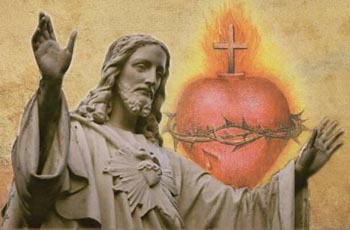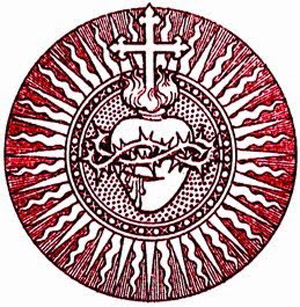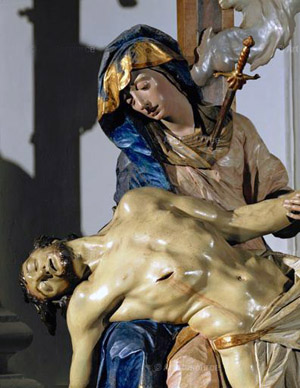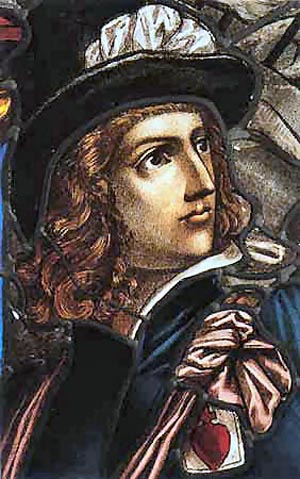the Sacred Heart Devotion
Plinio Corrêa de Oliveira
Devotion to the Sacred Heart of Jesus is at the root of all counter-revolutionary movements, large or small, well known or obscure, that have sprung up since the time St. Margaret Mary received this revelation in the 17th century. She received the mission, in the name of the Sacred Heart of Jesus, to ask King Louis XIV to consecrate France to the Sacred Heart and to put the Heart of Jesus on the coat of arms of France.
 The Sacred Heart of Jesus |
Clearly, should he have taken this course, the devotion to the Sacred Heart would have spread throughout the whole world. There would have been a good reception in France for the preaching of St. Louis Grignion de Montfort – who also lived at that time. Consequently, his preaching would have extended throughout the whole world and, thereby, the French Revolution could have been avoided.
By means of this request made to the King, the Revolution – in the form it had at the time of St. Margaret Mary – would have been halted, and that evil form which it took later - the French Revolution - would have been prevented.
Therefore, this devotion, from its first movement, from its first indication on the part of the Sacred Heart, has a clearly counter-revolutionary meaning.
Objections to this devotion
In a careful study of this devotion, Professor Fernando Furquim calls attention to the fact that the various counter-revolutionary movements that rose up in the 18th and 19th centuries were linked to the Sacred Heart of Jesus. For example, the French counter-revolutionaries of the Vendée, the Chouans, wore a badge of the Sacred Heart. This devotion invariably has been taken up by the good, inspiring and encouraging them, just as it has been hated by the bad.
 It is perfectly correct to have devotion to a specific organ of Christ |
Then, they go on to say, “This is a sentimental devotion. The heart is the symbol of emotion for the sentimental. So it is a sentimental devotion lacking any theological content and should not be allowed."
A devotion promoted by the Church
In fact, in many solemn, substantial and magnificent papal documents, the Holy See recommended this devotion, e.g., the Encyclical Inscrutabile Divinae Sapientiae of Pope Pius VI in 1775. The Holy See granted many indulgences for those receiving Communion on the First Fridays in reparation for the offenses made against the Sacred Heart. It also showered indulgences on the fraternities and archconfraternities it established in support of the Sacred Heart devotion.
Further, it approved and encouraged the building of churches, altars and statues in honor of the Sacred Heart. The Church, therefore, has approved this devotion superabundantly and it thus has every reason to deserve our trust.
As for the argument that you cannot have a devotion to each part of the Sacred Body of Our Lord, this is without any merit. In fact, in our private devotions, we can adore Our Lord in His Sacred Hands; we can and we should adore Him in His infinitely expressive, eloquent, regal, instructive and saving Eyes. One need only recall that it was a glance of Our Lord that moved St. Peter to repent for his triple denial in order to realize that to adore Our Lord in his divine Eyes is certainly something one can do.
But the Church, who has a strong sense of the ridiculous and understands that the ridiculous can be one step away from the sublime, understands that vulgar minds are always quick to employ sarcasm to degrade devotions like these to a part of the body, which really can shock human sensitivities. But such devotions are not against reason, and can most appropriately be made.
 Our Lady adored the body of her beloved Son |
A beautiful way to worship Our Lord Jesus Christ is to unite ourselves to the thoughts and meditations of Our Lady when Our Lord was taken down from the Cross, when she held His Sacred and blood-drained Body in her lap. She contemplated the part of that macerated Body with boundless love, veneration, respect and affection. She considered the members and adored them in their significance and function. She measured the offense against His divinity in having those parts flagellated. With this, in short, she practiced this devotion, adoring different parts of her Divine Son’s Body.
Therefore, it is only for a question of convenience, a sense of appearances and proportion, so to speak, that keeps the Church from promoting the adoration of many of the parts of the Body of Our Lord.
What is devotion to the Sacred Heart?
What exactly is devotion to the Sacred Heart? It is the devotion to the organ of Our Lord that is the Heart. But in Scripture, the heart does not have the sentimental meaning it took on at around the end of the 18th century, and certainly in the 19th century. The heart does not express sentiment.
When Scripture says: "With my whole heart have I sought thee,” (Ps 119:10) the heart here is the human will, the human purpose, properly said, human holiness. Thus, when the Prophet says this, he means, "With my whole will I have sought thee.” The Gospel also says: "Our Lady kept all these words, pondering them in her heart.” (Luke 2:19) You can see that it is not a sentimental heart spoken of here, but her will, her soul, that guarded these things and thought about them.
 |
By correlation, there is the immensely significant devotion of the Immaculate Heart of Mary. The Immaculate Heart of Mary is a shrine inside which we find the Sacred Heart of Jesus.
Our Lord promised an outpouring of grace for this devotion. The Sacred Heart made special promises to those who make the nine First Fridays. The most striking of them, perhaps, is that those who make the Nine First Fridays will not die without the grace of final repentance. This is not to say that they will certainly go to Heaven. It is to say that they will have a great grace before they die, so great that every hope can be had for their salvation.
You understand how diligently the Church has strived in the past for this devotion to be known, appreciated and understood by our reason without sentimentalism. A manly devotion seeks the reason for a thing and then loves that thing for its reason of being. It is in this way that the strong man and strong woman of the Gospel judge pious things.
Therefore, we should ponder this devotion and turn our souls, our wills, to the Heart of Jesus as the source of those graces Divine Providence planned to give men in the epoch of the Revolution. It is a means of grace intended for the difficult times to come, these very times in which we live today.
We should ask the Heart of Jesus, through the blood and water that flowed from It, to cleanse and restore us. This is my suggestion when you meditate and pray on Fridays, and especially on the first Friday of the month and the Friday of Passion Week.
I close, reminding you of that soldier who pierced the Heart of Jesus with a spear. Upon making this act of violence against the Sacred Heart of Jesus, the water and the blood poured from the side of Our Lord and spilled onto his eyes. Then, the eyes of the soldier, who was becoming blind, were immediately healed and he regained his sight. For us, this is most eloquent and significant.
It means that those who have devotion to the Sacred Heart of Jesus may ask for similar graces, not necessarily the physical miracle, but rather a grace for our souls. If we want to have the Catholic sense, a counter-revolutionary understanding of things, if we want to perceive how the Revolution and Counter-Revolution are working around us and in us, if we want to know our defects, to understand the souls of others to do good for them, to have keen insight in our studies, to have a good psychological equilibrium and be cured of nervous problems of all types, then we can and we must have recourse to the Sacred Heart of Jesus.
We should ask for a grace pouring from His Sacred Heart – like the blood and water that cured the soldier – that will eradicate the total or partial blindness of our souls. Let us pray, then, to the Sacred Heart of Jesus through the Immaculate Heart of Mary, for this is the only way we will obtain the graces to cure us from our multiple blindnesses. Doing this, we will make a splendid request and be on the road to obtaining a magnificent grace.
1. Cf. Marguerite-Marie Alacoque, Vie et oeuvres, Paris-Fribourg: Saint Paul, 1990, vol. II, pp. 335-337, 343-344, 435-436 Saint of the Day, March 4, 1965
